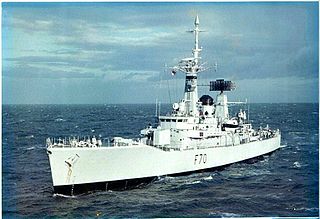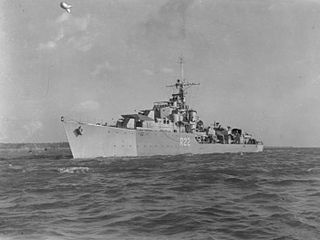History
By 1945 the wartime "utility" vessels were obsolescent as destroyers due to their relatively small size and makeshift armament. Future construction would be based on ever larger vessels, such as the Battle class and Daring class. Rapid advances in German U-boat technology with the 17- knot (31 km/h; 20 mph) Type XXI and 19-knot (35 km/h; 22 mph) Type XXVI rendered even some of the most modern Royal Navy escorts obsolete. This technology was being put into production by the Soviet Navy in the form of the Whiskey-class submarine. The Royal Navy began designing and constructing new fast anti-submarine frigates of the Type 12 and Type 14 design to counter this threat. However, it would be some time before these vessels could be brought into service and budget constraints limited the number of new hulls that could be constructed.
The solution to the problem lay in the 47 War Emergency Programme destroyers that remained in Royal Navy service, most of which were only a few years old and had seen little active service. Accordingly, plans were drawn up to convert these vessels into fast anti-submarine frigates incorporating as many lessons learned during wartime experience as possible. Ultimately, 23 of the utility destroyers were fully converted into Type 15 first-rate anti-submarine frigates, and a further ten were given limited conversions, and designated Type 16 frigates.
The US Navy followed suit in 1960–65, with the "FRAM" program, by which Fletcher, Allen M. Sumner and Gearing-class destroyers were progressively upgraded, pending the arrival of new Knox-class frigates and Spruance-class destroyers in 1969.
Conversion
Before conversion began, all superstructure, weaponry, masts and equipments were removed and the machinery was overhauled. The forecastle was extended aft to leave only a small quarterdeck, providing much improved accommodation, the lack and poor quality of which had been a source of constant problem for large wartime crews. A new single-level superstructure incorporating the fully enclosed bridge (a novelty in a British escort ship), operations room and a sonar room was added spanning the full width of the hull in front of the funnel. The new superstructure layout allowed the crew to fight the ship without having to expose themselves to the elements, and was increasingly important in the age of nuclear weapons. New lattice masts were provided to carry the range of radars, HF/DF and communications equipment that were now required for a naval escort. Troubridge, Ulster and Zest were fitted with a new design of bridge that would be adopted in all subsequent British frigates up to the Leander class. This bridge had angled sides and raked windows, to allow good all-round vision and cut down on internal reflections at night.
A completely new suite of armaments and electronics was added, befitting their role as fast anti-submarine frigates. The principal anti-submarine armament was a pair of Mark 10 Limbo anti-submarine mortars. These three-barrelled weapons were based on the wartime Squid, and were mounted on the quarterdeck aft, where they were best protected from the weather. They had a 360° field of fire and were automatic in operation. It had been intended to carry a new anti-submarine weapon, the Mark 20E torpedo, in a pair of trainable tubes on each beam, but this weapon was a failure and the tubes, where fitted, never received weapons and were later removed. Rapid, Roebuck and all V and W-class ships carried Squids in lieu of Limbo due to insufficient funds existing to fit all ships with Limbo. For self-defence, a twin 4 inch gun on a Mounting Mark XIX was carried aft, controlled by the MRS-1 Close Range Blind-Fire director (CRBF). Behind the bridge was fitted a twin 40 mm Bofors gun on a "utility" Mounting Mark V.
Many vessels were used during their peacetime service as seagoing training ships, for which purposes the 40 mm gun was removed and a large open bridge was added above the rounded face of the existing bridge. Undaunted was built with a flight deck aft, and was used for trials of the Fairey Ultra-light and Saunders Roe P531 helicopters. Undaunted became the first frigate to carry and operate a helicopter. Grenville had a flight deck fitted in 1959, but this was later removed.
Type 15s in film and models
HMS Wakeful and HMS Troubridge were both used in the filming of the 1965 cold-war drama The Bedford Incident , to depict the fictional "USS Bedford". The main exterior shots used a large model of a US Farragut-class destroyer, but Wakeful's Type 15 outline and F159 pennant number are clearly visible in the opening sequence, when Sidney Poitier arrives in a Whirlwind helicopter. Many of the interior shots were filmed in Troubridge, and British military equipment, including a rack of Lee–Enfield rifles and Troubridge's novel forward-sloping bridge windows, can be seen.
In 1959 Triang Minic Ships produced a series of 1:1200 (one inch to 100 feet) metal models of Type 15 frigates, carrying the names Vigilant, Venus, Virago and Volage; the first two have open bridges, while the others' are closed. These toys were mass-produced in large numbers between 1959 and 1965, and did much to raise awareness of the post-war navy for the younger generation. At the same time the Frog (models) company produced an accurate plastic model kit of HMS Undine to a scale of 1:500. The moulds for this were sold to Russia in 1976, and it has been re-issued under the "Novo" trademark on several occasions. More recently, Uk company MT Miniatures has produced a 1:700th scale model of HMS Relentless in resin, white metal, and photo-etched brass.

HMAS Queenborough (G70/D270/F02/57) was a Q-class destroyer that served in the Royal Navy (RN) and Royal Australian Navy (RAN).

The Type 21 frigate, or Amazon-class frigate, was a British Royal Navy general-purpose escort that was designed in the late 1960s, built in the 1970s and served throughout the 1980s into the 1990s.

The Leander-class, or Type 12I (Improved) frigates, comprising twenty-six vessels, was among the most numerous and long-lived classes of frigate in the Royal Navy's modern history. The class was built in three batches between 1959 and 1973. It had an unusually high public profile, due to the popular BBC television drama series Warship. The Leander silhouette became synonymous with the Royal Navy through the 1960s until the 1980s.

The Type 12 or Whitby-class frigates were a six-ship class of anti-submarine frigates of the Royal Navy, which entered service late in the 1950s. They were designed in the early 1950s as first-rate ocean-going convoy escorts, in the light of experience gained during World War II. At this time, the Royal Navy were designing single-role escorts and the Whitbys were designed as fast convoy escorts capable of tackling high-speed submarines. However, this made the Whitbys more expensive and sophisticated to produce in large numbers in the event of a major war, and so the Type 14 "utility" or "second-rate" anti-submarine frigate was developed to complement the Type 12. Although themselves rapidly outdated, the Type 12 proved to be an excellent basis for a series of frigate designs used by the British and Commonwealth navies for the next 20 years.

HMS Cleopatra (F28) was a Leander-class frigate of the Royal Navy (RN). Cleopatra was built at HMNB Devonport. She was launched on 21 March 1964, commissioned on 1 March 1966 and decommissioned on 31 January 1992.

The Type 82 or Bristol-class destroyer was a 1960s guided missile destroyer design intended to replace County-class destroyers in the Royal Navy. Originally eight warships were planned to provide area air-defence for the four planned CVA-01 aircraft carriers. They would also have been able to operate independently as modern cruisers "East of Suez".

The Flower-class corvette was a British class of 294 corvettes used during World War II by the Allied navies particularly as anti-submarine convoy escorts in the Battle of the Atlantic. Royal Navy ships of this class were named after flowers.

The Weapon class was a class of destroyers built for the British Royal Navy towards the end of World War II. They were the smaller counterpart to the Battle class and were the first new destroyer designs for the Royal Navy since the Second World War Emergency Programme. 20 ships were planned, of which only 13 were laid down and 7 were launched, but the cessation of hostilities resulted in only 4 being completed for service. Two of the ships had been previously ordered as part of the planned C class, or 15th Emergency flotilla, of 1944, but the orders were changed to the new design.

The S and T class was a class of sixteen destroyers of the Royal Navy launched in 1942–1943. They were built as two flotillas, known as the 5th and 6th Emergency Flotilla, and they served as fleet and convoy escorts in World War II.

HMS Yarmouth was the first modified Type 12 frigate of the Rothesay class to enter service with the Royal Navy.

The Loch class was a class of anti-submarine (A/S) frigate built for the Royal Navy and her Allies during World War II. They were an innovative design based on the experience of three years of fighting in the Battle of the Atlantic and attendant technological advances. Some shipyards had trouble building these larger ships, which led to widespread use of the Castle-class corvette, introduced around the same time.

HMS Torquay was a Type 12 Whitby-class frigate of the British Royal Navy. They were the first frigates to have the "V" form hull. This evolutionary design made it possible to be driven in head sea without the usual slamming which occurs with conventional destroyers of the time. Each frigate cost 3.5 million pounds and the first ship completed was Torquay in May 1956.

HMS Grenville was the second ship of this name to serve with the Royal Navy in the Second World War. Grenville and seven other U-class destroyers were ordered as part of the Emergency Programme. She was launched at Swan Hunter and Wigham Richardson Ltd., Wallsend-on-Tyne on 12 October 1942 and commissioned on 27 May 1943.

The Rothesay class, or Type 12M frigates were a class of frigates serving with the Royal Navy, South African Navy and the Royal New Zealand Navy.
The War Emergency Programme destroyers were destroyers built for the British Royal Navy during World War I and World War II.

HMS Rothesay was the lead ship of the Rothesay or Type 12M class of anti-submarine frigates of the British Royal Navy. She was commissioned in 1960 and scrapped in 1988.

HMS Lowestoft was a Rothesay-class or Type 12 class anti-submarine frigate of the British Royal Navy. Lowestoft was reconstructed in the late 1960s to largely the same pattern as the third group of Leander-class frigates, with new radar and fire control and a hangar and pad for a Westland Wasp helicopter for longer range, anti-submarine, engagement. In the late 1970s it was converted as the prototype towed array frigate for the Royal Navy, but retained its full armament. Lowestoft was sunk as a target on 8 June 1986 by HMS Conqueror using a Tigerfish torpedo. She was the last Royal Naval target to be sunk still displaying her pennant number.

HMS Troubridge was a T-class destroyer of the British Royal Navy that saw service during the Second World War. Post war she was converted into a Type 15 frigate.

HMS Undaunted was a U-class destroyer of the British Royal Navy that saw service during World War II. She was later converted into a Type 15 fast anti-submarine frigate, with the new pennant number F53.

HMS Ursa was a U-class destroyer of the Royal Navy that saw service during the Second World War. She was later converted into a Type 15 fast anti-submarine frigate, with the new pennant number F200.
This page is based on this
Wikipedia article Text is available under the
CC BY-SA 4.0 license; additional terms may apply.
Images, videos and audio are available under their respective licenses.




















